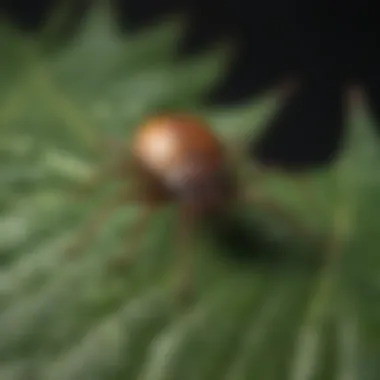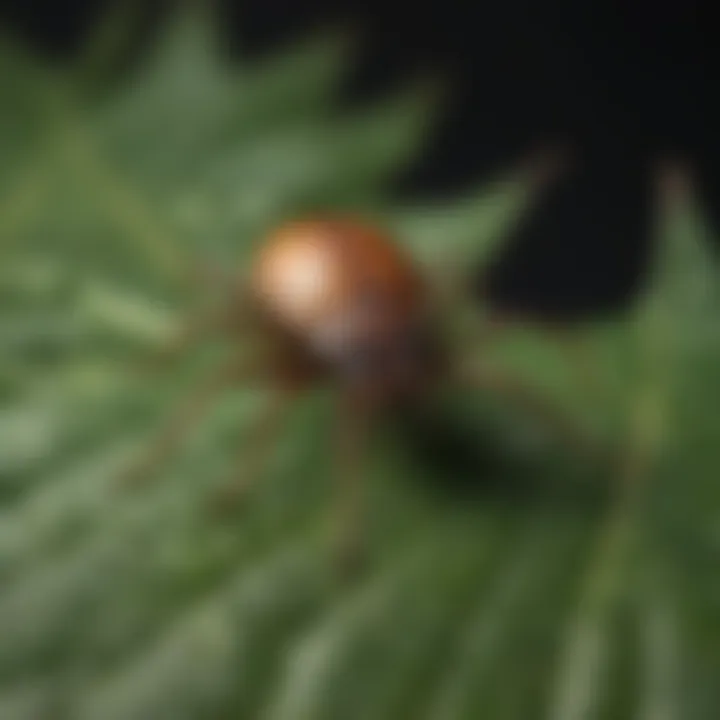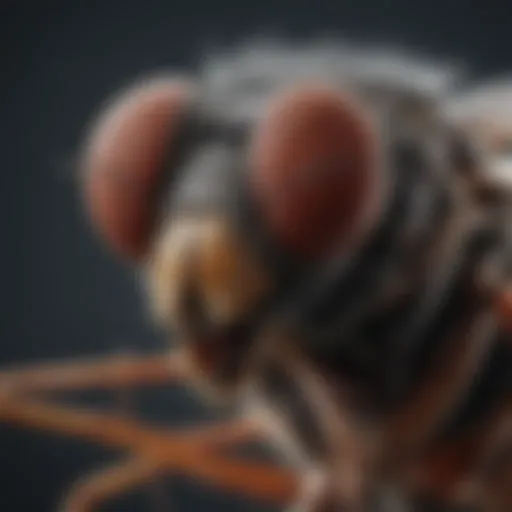Effective Strategies to Use Spray for Tick Elimination


Preventive Pest Control Strategies
Ticks eagerly find their way into our lives, especially in gardens or areas with tall grass. To maintain a tick-free environment, preventive strategies are vital. This section covers essential steps for tick prevention—installing barriers both inside and outside the house to ensure a proactive approach against these pests.
House Exterior Protection
For effective tick control, building a strong safeguard around your home is crucial. You can protect your home’s exterior through several practical measures:
Tips for sealing cracks
Start by checking every door and window frame. Applying caulk to fills gaps is essential as it blocks potential ticks that thrive in small crevices. Weather stripping particularly around pests entrances also helps. Inspect for chinks in the walls or the foundation—maintaining these areas often reduces pest access.
Clearing debris
Clear away leaves, brush, and debris from the house perimeter. Yard clutter provides ideal habitats for ticks. Regular cleaning reduces potential nesting areas. Trim tall grasses and minimize underbrush in yards for effective yard management.
Preventing pests from entering
Use screens on windows and doors to keep pests out. Regular maintenance of these barriers ensures immediate problem detection. Consider installing insect-resistant lighting fixtures if you frequent outdoor evenings. Also, placing barriers and traps near the home periphery can provide an additional level of defense.
Yard Maintenance
Creating a pest-free yard involves routine upkeep. Necessary tasks include:
Essential yard care routines
Ensuring your yard is well-groomed contributes substantially. Regular mowing keeps grass at a low height. Also, removing off-hanging branches or shrubs clusters eliminates additional environments for ticks.
Methods for keeping yard pest-free
Clearly delineating your landscape by establishing a rock border creates a buffer against ticks. Moreover, employing wood chips or gravel around certain areas can help manage humidity levels, which ticks thrive on. You may even introduce native plants which repel unwanted pests.
Indoor Cleanliness
Ticks do not only care about outdoor environments; they opportunistically invade homes. Maintain thorough indoor cleanliness:
Expert cleaning tips and techniques
Employing regular vacuuming significantly cuts down on tick presence. Consistently clean carpets, upholstery, and under furniture. Also, wash bedding and pet linens regularly in hot water. After cleaning, promptly dispose of vacuum contents outside to eliminate missed ticks.
Maintaining a pest-resistant indoor environment
Immediate food and liquid spills must be tended to. Ticks are often attracted to specific residues. Using clear containers to store food minimizes attractants as well.
Garbage Disposal
Garbage must be managed effectively to avoid attracting ticks:
Efficient waste disposal methods
Ensure your trash cans are tight-fitting and located far from the house. Regular waste collection helps maximize sanitation.
Importance of proper garbage disposal
Consider composting fruit and vegetable scraps in a sealed container, keeping attractants limited. The prime aim should be a clean-setting that reduces that enables rodent free approach.
Other Pest Prevention Strategies
Besides basic cleaning and maintenance, explore other unique strategies:
Innovative ways to safeguard your home
Focus on practicing careful pest monitoring and using beneficial insects that can naturally deter ticks. Encouragement of birds or predatory insects around your yard reduces pest tags. Monitoring potential risks through environmental awareness can completely shift outcomes.
Remember, implementing preventive measures significantly aids in keeping ticks at bay. A group effort creates a comfortable, safe living space.


Understanding Ticks
Ticks have become a substantial concern for homeowners. They are more than just a nuisance; ticks introduce significant health risks through their bites. Understanding ticks is crucial. Knowledge equips homeowners to take necessary steps against infestations and enhances the effectiveness of tick sprays. It helps them identify these pests, recognize their habitats, and understand the dangers associated with them, which is critical for combating the issue effectively.
Biology and Lifecycle of Ticks
Ticks belong to the arachnid class, which includes spiders. This designates them as relatives of spiders, contributing to their unique biology. They undergo four stages: larva, nymph, adult, and egg. The larval stage occurs after they hatch, typically in spring, leading to nymphs as they feed during the summer. Adults usually become active in the fall. In optimal environmental conditions, ticks can survive for several years without a host, making them persistent pests. Each lifecycle stage has specific requirements for sustenance and dwellings, which differ, affecting how homeowners should apply sprays. Understanding these public-freefeeding stages helps in the timing and thoroughness of control measures.
Common Species of Ticks
Different tick species pose various threats, each with distinctive characteristics. Important ticks to recognize include:
- Black-legged tick (Lxodes scapularis): Known for transmitting Lyme disease. This tick is smaller and often difficult to spot.
- American dog tick (Dermacentor variabilis): Commonly found in open fields and forests and can lead to Rocky Mountain spotted fever.
- Lone Star tick (Amblyomma americanum): Identified by a white spot on its back, can cause allergies and diseases like ehrlichiosis.
- Brown dog tick (Rhipicephalus sanguineus): Almost exclusive to dogs, they can infest homes actively and may transmit Babesiosis.
Recognizing these species is step one to an effective spraying strategy. Homeowners need to use the correct products, as some may be more effective against specific species.
Health Risks Associated with Ticks
Ticks are vectors for multiple diseases, making them a considerable health concern. Their bites often transmit pathogens into the bloodstream of their hosts. Important health risks stemming from tick bites include:
- Lyme disease: A condition characterized by fever, fatigue and the hallmark circular rash.
- Rocky Mountain spotted fever: Symptoms may escalate to serious, life-threatening conditions without prompt treatment.
- Anaplasmosis: A bacterial infection that can lead to hospitalization if untreated.
- Babesiosis: Particularly concerning for immunocompromised individuals, it is a malaria-like illness.
Understanding ticks and their associated risks prepares homeowners to act promptly if they encounter Tick bites. Timely responses can save lives and promote a safe living environment.
Tick Habitats in the Home
Ticks often make their homes in specific environments, making it critical to understand these habitats for effective control. These habitats can vary depending on the season, temperature, and humidity levels. By identifying where ticks thrive, homeowners can better tackle infestations. Knowledge about tick habitats helps in devising plans for tick Spray application, ultimately leading to a safer living space.
Identifying Potential Tick Hiding Places
To effectively eliminate ticks, one must identify the spots where they commonly hide.
- Wooded areas often attract ticks due to ample shade and humidity.
- Thick grass, especially overgrown runners of large lawns, can also serve as a retreat for these pests.
- Shrubs and underbrush are other favorite areas, where ticks lie in wait for hosts to pass by. Check these areas carefully when leading your pets outdoors.
Common indoor hiding places may include:
- Basements or crawl spaces with damp conditions.
- Laundry areas, as ticks can come inside on clothing. In anything reused across your floors or clothes it might contain a byproduct matching their reproduction.
- Under furniture, and especially along the edges of carpets where can be lodged.
Proper surveillance of such locations diminishes tick reproduction. Addressing moisture and clutter assists directly in eliminating potential hideouts.
Areas Most Prone to Tick Infestation
Certain parts of homes have a heightened risk for tick infestations. Regular monitoring is suggested to avoid larger outbreaks.
Outdoor areas:
- Borders of wooded lots.
- Perimeter of yards should be kept clean from any debris that may harbor ticks.
- Near water bodies, like lakes and ponds, ticks find environments favorable.
Indoor inclusing areas:
- Entry points like porch and patio should be sanitized.
- Bathrooms and kitchens where moisture persists can also support tick presence.
- Living spaces right by outdoor paths or entry points, due to transfer from kids returning indoors from play.
Types of Sprays for Tick Control
Understanding the variety of sprays available for tick control is crucial for homeowners looking to effectively manage tick populations. The choice between chemical and natural sprays can deeply impact efficacy, safety and the environmental footprint left by the application. Proper inspection of these options ensures homeowners can select the most suitable solutions tailored for their unique situations.
Chemical Sprays: Pros and Cons
Chemical sprays remain a popular method in the fight against ticks. One of the significant benefits is their potency; chemicals such as permethrin or bifenthrin are highly effective and can act quickly against tick infestations.
Pros:
- Immediate results: Chemical sprays often eliminate ticks on contact.
- Long-lasting protection: Some formulations provide residual effects for weeks, continuously guarding against ticks even after initial application.
- Wide range of availability: Many products are easily accessible at local stores or online.
Cons:


- Health risks: Chemical residues could lead some family members, pets, or even the environment to be at risk. Caution in usage is advised.
- Potential resistance: Over time, ticks can develop resistance to certain chemicals, making them less effective.
- Environmental concerns: Chemicals may have detrimental effects on local biodiversity, especially if misused.
To safely use venomous sprays, understand the product's ingredients. Knowing specific kill times and affected species helps maximize your use.
Natural and Organic Sprays
Natural and organic sprays are gaining attention, particularly among environmentally conscious homeowners. Many of these options utilize plant-extracted ingredients or biopesticides, which can be less harmful than harsh chemicals. Citronella, cedar oil, and neem oil are common examples of effective natural additives.
- Safer for children and pets: These sprays generally pose lower risks to the household than their chemical counterparts.
- Environmental friendly: Reducing the ecological impact is a significant advantage for those looking to protect their living environments and nearby wildlife.
- The challenge of efficacy: These products might not be as immediate or long-lasting in certain situations. Therefore, multiple applications might be necessary for ongoing control.
Organic sprays may sometimes prevent the habit of oversaturating areas, thus encouraging insights about ticks based on eco-responsibility when used wisely.
Comparison of Popular Tick Sprays
Exploring various dishonest tick sprays currently in markets focusing on strengths and weaknesses will benefite someone wishing to avoid ticks before they come in. Careful research can assist one in choosing a product which closely matches their preferences. When reviewing brands like PetArmor, EcoSMART, and Tickless, consider both commitment to health-oriented ingredients and proven effectiveness.
Considerations when Comparing Products:
- Efficacy: Evaluate how suitable each product is against tick species known to inhabit your area.
- Application ease: Some sprays call for elaborate preparations while others promise straightforward application.
- Family safety: Products labeled for household use versus yard applications must fulfill safety precaution obligations.[Source: Wikipedia]
- Cost: Overall, there is significant promotion for more costly bet solutions without clear benefits.
By weighing the information surrounding different tick sprays, one can filter product choices to adapt various approaches according to relevant personal or local conditions.
How to Apply Tick Spray Effectively
Applying tick spray correctly is crucial for effective pest control. This process not only helps in eliminating ticks but also ensures the safety of the household. Understanding how to use these sprays effectively allows homeowners to minimize their anxiety over potential tick exposure, laying a solid foundation for a tick-free home.
Preparation Before Spraying
Before applying tick spray, preparation is key. Start by gathering all necessary supplies. This includes the tick spray itself, personal protective equipment such as gloves, a mask, and barrier clothing to minimize direct contact with the pesticide. Ensure that pets and family members are far from the area to be treated.
Next, decide on an appropriate time for application. Ideally, choose a calm day; winds can drift the spray to unintended areas. Additionally, check the product label for specific instructions related to conditions and surface types.
Furthermore, ensure the area is clean. Remove any debris or clutter that might shelter ticks. This not only maximizes spray efficacy but also leaves no places for ticks to hide. Keeping in mind these preparation steps enhances the overall outcomes and enhances the safety of working in such environments.
Step-by-Step Application Process
- The first step is shaking the tick spray canister to mix the active ingredients uniformly. This helps in achieving maximum effectiveness.
- Hold the spray canister at a recommended distance from the surface – generally around 12 to 18 inches.
- As you start spraying, ensure to cover high-traffic areas, edges, and crevices, as these spots are typical hiding areas for ticks.
- Apply the spray in sections. This organized method allows you to monitor coverage and avoid overspray.
- It’s often suggested to focus on areas around dense vegetation, where ticks thrive.
- Allow for adequate drying time post-application, as recommended on the product label.
The manner of application is just as important as the spray itself. Prioritizing detail minimizes oversight and maximizes effectiveness against ticks.
Frequency of Application
Knowing how often to apply tick spray matters significantly. Depending on the type of spray used, follow specific instructions. Chemical sprays generally necessitate a reapplication every 30 days or less, especially in areas known for persistent tick presence. For natural and organic options, some may last longer based on environmental factors.
Also, consider seasons. Spring and summer typically see higher tick activity. Thus, more frequent spraying during those times can help in establishing a barrier against ticks. Furthermore, any considerable rainfall may warrant an additional application, as water can wash away treatment effectiveness.
By understanding when and how often to apply tick sprays, strategies can evolve year-round, ensuring effective pest control without routinely feeling overwhelmed by tick concerns.
Safety Precautions When Using Tick Spray
Using tick spray is an effective method for controlling ticks around your home. However, employing these substances requires thoughtful consideration of safety precautions. These measures not only protect your family but also ensure the health of pets and the environment.
Key Importance of Safety Precautions
- Using tick sprays correctly minimizes any adverse affects on health.
- Ensures pets are not harmed during treatment.
- Prevents unintended contamination of surfaces.
- Helps maintain a healthy living space while effectively combating ticks.
Protecting Pets During Treatment
Pets often explore spaces where tick sprays can be applied, putting them at risk if proper precautions are not taken. Before using the spray, confined your pets to an area where treatment is not taking place.
After treatment, wait until surfaces are dry and any volatile chemicals have subsided. This might take a few hours and depends on factors like humidity and ventilation. Pets can be curious; therefore, monitor them and reintroduce them to treated areas cautiously. Use the following steps to protect your pets:
- Read the Label: Always follow specific instructions on the product, including re-entry time for treated areas.
- Use Barriers: Consider barriers, such as gates, to limit movement into treated areas until it is safe.
- Consult Your Vet: If uncertain about a product’s safety, asking a veterinarian can be very helpful.
Avoiding Health Risks for Family Members
Family safety hinges on adhering to guidelines during and post-application of tick sprays. The chemicals can be hazardous if inhaled or consumed, especially by children and elderly. Taking proactive steps adds an extra layer of security.


Not adhering to safety measures can lead to serious health risks, including respiratory issues and skin irritation.
Follow these practices to keep family members secure:
- Ventilation: Ensure proper ventilation in affected areas. Open windows and doors to air out spaces after treatment.
- Store Properly: Keep sprays in a secure location, out of reach of children, to avoid accidental exposure.
- Wear Protective Equipment: Utilize gloves and masks during application to limit personal exposure to chemicals.
- Clear Children from the Area: Keep children away from treated spaces until it's safe. Educate them on avoiding freshly treated areas and practice safety whenever introducing any pest control substances.
By implementing these strategies, your family can enjoy the benefits of tick sprays, while still prioritizing safety in your home.
Evaluating the Effectiveness of Tick Sprays
When it comes to managing ticks in residential areas, ensuring that the methods important are effective makes a significant difference. Evaluating the effectiveness of tick sprays is vital for homeowners. It confirms that chosen products perform well against ticks. We'll examine why this evaluation is crucial. First, it might safeguard the health of all family members, including pets. This aspect often requires close attention, as ticks are known vectors for a range of diseases.
Next, successful reduction of ticks alleviates worries associated with tick-borne illnesses. Examples are Lyme disease or Rocky Mountain spotted fever. Knowing if the spray works can help in planning preventive measures for the future too. Monitoring changes in tick populations creates better awareness of one's environment.
Lastly, identifying effective sprays can often lead to cost savings. A user can avoid investing in products that do not yield significant results.
Signs of Tick Elimination
Recognizing the signs of tick elimination is an essential skill for homeowners. First, observing a drastic drop in the number of ticks seen is the most apparent sign. After applying sprays, reduced sightings can be expected.
Another indicator can be the decrease in ticks found on pets after their walks outside. For example, consistently checking pets for ticks before they come indoors works well for elimination assessments. If fewer ticks are detected, it signals progress in controlling the infestation. Also, people can notice changes in the behavior of outdoor activities. If individuals can freely enjoy their yards again, it suggests lower toxicity from ticks.
Families are encouraged to regularly conduct checks and document these observations over time. Keeping a record could help track both successes and adjustments needed for even better performance.
When to Seek Professional Help
There are times when handling tick problems independently may not result in good outcomes. If despite thorough treatment with sprays there is no sign of reduction in ticks, it may be time to consult professionals.
Experts possess knowledge of advanced treatments, suitable for severe infestations. They could identify issues maps simple sprays might miss. If a family commonly encounters ticks during everyday activities, it’s often suggested to request expert assistance with proper pest control systems. Such interventions minimize risk factors professionally.
The effectiveness may on house conditions and nearby biotopes too. Professionals help study resident’s landscape and dwelling posture. Personal research maybe limit success. Knowing the right candidates for serving will enhance good outcomes.
Consulting with professionals not only saves time but can help maintain a safe home environment. Join those who are serious about erasing ticks from their lives. Engaging at this level can bring long-term peace of mind.
Long-Term Prevention Strategies
Long-term prevention strategies are critical for maintaining a tick-free home and surroundings. Understanding how ticks thrive allows homeowners to implement effective measures that reduce tick populations over time.
Focusing on the landscape, it is important to create an environment that is less hospitable to ticks. This involves careful yard maintenance and identityfing areas where ticks may flourish. For instance, reducing tall grass, minimizing leaf litter, and restricting access of deer and other animals are effective ways to decrease tick habitats around your home.
Furthermore, maintaining a distance from wooded areas can significantly lower the chance of ticks entering your property. Designated pathways for walking can help avoid tall grass or brush. Incorporating ticks-resistant plants in gardens is another method to deter ticks. Such strategies contribute to a diverse flora that can fend off ticks effectively.
An effective strategy involves continually monitoring and adapting your landscape for tick prevention.
Preventative Measures for the Landscape
In your landscape, adjustments are essential to minimize the risks.
- Mow the Lawn Regularly: Keeping grass at a short height is important. Mowing every week can significantly restrict tick habitats.
- Trim Shrubs and Bushes: Ensure there is no dense foliage touching your home. This is crucial in reducing surfaces where ticks can rest.
- Create a Barrier: Consider a gravel or wood chip barrier around gardens to separate tick habitats from play areas.
- Eliminate Excess Debris: Rake up leaves, clear away woodpiles or any unnecessary clutter, as these attract rodents that may carry ticks.
While small changes can help, larger scales adaptations can enhance the impact of your preventive measures. Planting shrubs or plants that naturally repel ticks, such as lavender or marigold, enhances diversity and minimizes the attraction of unwanted pests.
Seasonal Considerations for Tick Control
Seasonal variations influence tick population dynamics and behaviors. Hence, taking this into account is necessary for year-round tick management.
- Spring: Early in spring, ticks emerge from dormancy. During this time, being thorough with landscaping practices – removing debris around gardens and spraying targeted areas – is beneficial.
- Summer: Ticks thrive in warmth. Regular monitoring of pets and family members, especially after outdoor activities, is advisable. Utilizing sprays in the yard during this season can limit aggressive tick behavior.
- Fall and Winter: As temperatures drop, ticks search for warm hosts. It may be easy to forget tick management during this time, but maintaining the landscape assists in keeping them at bay.
Adopting these seasonal strategies creates a proactive approach, helping to minimize heavily populated tick seasons, thus fostering a safer home environment. A consistent yearly commitment alongside continuous evaluation of the landscape generates a long-lasting tick prevention strategy.
Closure
Importance of Diligent Tick Control
Controlling ticks in one’s home is not just about immediatly elimination. It involves a commitment to maintaing a tick-free enviromenent that safeguards the health of all residents. Ticks pose serious health risks as they transmit various diseases like Lyme disease and Rocky Mountain spotted fever.
Diligent tick control includes recognition and early intervention. When homeowners use effective sprays, they reduce the tick population, leading to decreased chances of tick bites. This can protect pets and family, promoting overall well-being.
Regular monitoring becomes an essential part of tick management. It is wise to routinely inspect living spaces and landscapes for signs of ticks. Early detection is key. Sprays should not only be viewed as a one-time solution but rather, part of an ongoing pest management strategy. Homeowners need to recombine spray applications with good maintenance practices like lawn care. Less overgrown areas is key to reducing tick habitat.
Remember: Continuous evaluation and reapplication of sprays during high-season is crucial for effective tick control.
Being proactive leads to lasting peace of mind. A home consistently free from ticks allows for worry-free enjoyment of outdoor spaces. The benefits are clear, and property owners take on the responsible action of controlling ticks effectively – for their household and emotional wellness.



